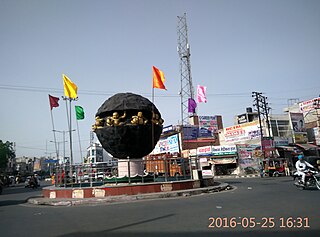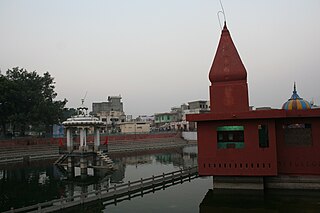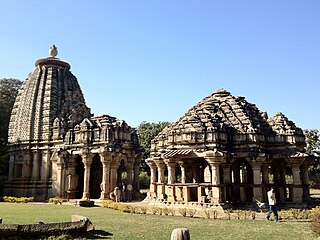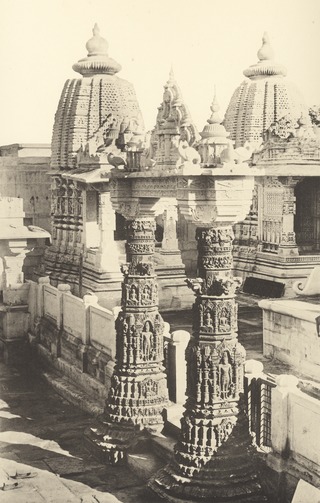
The Gurjara-Pratihara was a dynasty that ruled much of Northern India from the mid-8th to the 11th century. They ruled first at Ujjain and later at Kannauj.

The Chandelas of Jejakabhukti was an Indian dynasty in Central India. The Chandelas ruled much of the Bundelkhand region between the 9th and the 13th centuries. They belonged to the Chandel clan of the Rajputs.

Kaithal is a city and municipal council in the Kaithal district of the Indian state of Haryana. Kaithal was previously a part of Karnal district and later, Kurukshetra district until 1 November 1989, when it became the headquarters of the Kaithal. It shares a border with the Patiala district of state Punjab and the Kurukshetra, Jind and Karnal districts of Haryana. Kaithal district is situated in the North-West of the Haryana state. Its North-West boundaries, which include Guhla-Cheeka are attached to Punjab.

Kurukshetra is a city and administrative headquarters of Kurukshetra district in the Indian state of Haryana. It is also known as Dharmakshetra and as the "Land of the Bhagavad Gita".

Kaithal district is one of the 22 districts of Haryana, a state in northern India. Kaithal town is the district headquarters. The district occupies an area of 2317 km2. It has a population of 1,074,304. It is part of Karnal division. Kaithal was notified as district by Haryana Govt. on 16 October 1989 and carved out of Kurukshetra and Jind districts, comprising Guhla and Kaithal sub-divisions of Kurukshetra district, Kalayat sub-tahsil and 6 villages of Jind district.
Kalayat is a town in Kaithal district in the Indian state of Haryana. It is historical town known as Kapilayat and Kapilayatana in past, named after the Vedic sage Kapil Muni, is home of the 8th century Kalayat Ancient Bricks Temple Complex. After Dwarka drowned, Ahir yadhuvansi Arjun along with Ahir women and children went towards Hastinapur via Kaithal.

Pehowa (old name Pitrudhak Teerth) is a town and a municipal committee in Kurukshetra district in the Indian state of Haryana. It is an important sacred Hindu pilgrimage site, related to Krishna and Mahabharata, within the 48 Kos Parikrama of Kurukshetra. The Hindu genealogy registers at Peohwa, Haryana are kept here at the Pruthudak Tirath on the banks of Sarasvati river.

Pinjore is a town in Panchkula district in the Indian state of Haryana. This residential 'township', located close to Panchkula, Chandigarh, is set over 1,800 feet above the sea level in a valley, overlooking the Sivalik Hills. Pinjore is known for Pinjore Gardens, Asia's best 17th Century Mughal garden, and the Hindustan Machine Tools (HMT) factory.

The Baroli Temples Complex, also known as the Badoli temples, is located in Baroli village in Rawatbhata City in Chittorgarh district of Rajasthan, India. The complex of eight temples is situated within a walled enclosure; an additional temple is about 1 kilometre (0.62 mi) away. They are built in the Gurjara Pratihara style of temple architecture dated to the tenth century CE and today show various degree of preservation, decay and destruction. All nine temples are under the control of the Archaeological Survey of India for conservation and protection. A well known art critic characterised "the creations of Badoli as the most perfect of their age that he had encountered within that part of the country and, in their own peculiar style."

Haryana is a state in India. The state houses several sites from the Indus Valley Civilization, which was a cradle of civilization. In the Mahabharata, Haryana is mentioned as Bahudanayak Region.

The Bhima Devi Temple Complex, nicknamed Khajuraho of North India for its erotic sculptures, comprises the restored ruins of an ancient Hindu temple dating from between 8th and 11th century AD, together with the adjacent 17th-century Pinjore gardens, located in Pinjore town in Panchkula district of the state of Haryana, India. The old temple was destroyed by Islamic invaders and the present 8-11th CE temple is likely built on the same place under the old name, and the nearby ancient baoli still has old Hindu pillars. Bhimadevi belongs to the Shakti tradition that was derived from the Buddhist tantric goddess. Further, in the Devi Mahatmya it is said that in the Western Himalayas of Himachal Pradesh, Bhimadevi appeared in an enormous form of Bhimarupa and gave protection to the sages. The site was worked upon extensively by the team of Speaking Archaeologically from 2017 to 2019, with preliminary survey beginning as early as in 2015 and the report was published as the Speaking Archaeologically Journal Volume III:Bhima Devi Project Edition in 2020.

Khajuraho is a city, near Chhatarpur in Chhatarpur district of the Indian state of Madhya Pradesh. One of the most popular tourist destinations in India, Khajuraho has the country's largest group of medieval Hindu and Jain temples, famous for their erotic sculptures. The Khajuraho Group of Monuments has been listed as a UNESCO World Heritage Site since 1986 and is considered one of the "seven wonders" of India. The town's name, anciently "Kharjuravahaka", is derived from the Sanskrit word kharjur meaning "date palm".
Saraswati Wildlife Sanctuary, also known as Seonsar Forest, is situated in Kaithal district of Haryana State, India. It is spread over an area of 4,452.85 hectares.
Adi Badri, also Sri Sarasvati Udgam Tirath, is a tourist site of archaeological, religious and ecological significance in a forest area in the foothills of the Sivalik Hills in Bhabar area, situated in northern part of Yamunanagar district, of the north Indian state of Haryana. There are remains of many Buddhist stupas and monasteries, which are about 1500–2000 years old, and there is also a group of Hindu temples from the 9th century. Based on the multiple archaeological excavations undertaken here, archaeologists have sent the proposal to Archaeological Survey of India (ASI) to include this site in the list of protected heritage site. Several popular annual festivals are held here, including the five day long National Saraswati Festival in January, Adi Badri Akha Teej Mela in Vaisakh around April–May, week-long Adi Badri-Kapal Mochan Kartik Purnima religious mela around November.
Tourism in Haryana relates to tourism in the state of Haryana, India. There are 21 tourism hubs created by Haryana Tourism Corporation (HTC), which are located in Ambala, Bhiwani Faridabad, Fatehabad, Gurgaon, Hisar, Jhajjar, Jind, Kaithal, Karnal, Kurukshetra, Panchkula, Sirsa, Sonipat, Panipat, Rewari, Rohtak, Yamunanagar, Palwal and Mahendergarh.

The 48 kos parikrama is a parikrama of various Mahabharata-related and other Vedic-era tirthas around the holy city of Kurukshetra in the state of Haryana, India.

Māru-Gurjara architecture or Solaṅkī style, is the style of West Indian temple architecture that originated in Gujarat and Rajasthan from the 11th to 13th centuries, under the Chaulukya dynasty. Although originating as a regional style in Hindu temple architecture, it became especially popular in Jain temples, and mainly under Jain patronage later spread across India, then later to diaspora communities around the world.
Rasina is an old village of in Pundri Tehsil in Kaithal district of Haryana State, India before 9th century AD. Its administration done by Pratihars and its situated in the cluster of Pratihars 84 villages. It lies in Kurukshetra of 48 kos area. It is located 29 kilometres (18 mi) towards east from district headquarters Kaithal, 34 km from Karnal, 12 kilometres (7.5 mi) from Pundri and 127 kilometres (79 mi) from state capital Chandigarh 155 km from Delhi. According to a 1918 survey, Rors held 84 villages in Pheoa and 12 villages beyond the Ganges. They had the strongest presence in Indri Nardak and Mori Nardak. They had substantial presence on the east of Pargana Kaithal and south of Kaithal tahsil near the Jind border. Rasina village presence is in Nardak area of Haryana.

The Mahavira Jain temple is built in Osian of Jodhpur District, Rajasthan. The temple is an important pilgrimage of the Oswal Jain community. This temple is the oldest surviving Jain temple in Western India and was built during the reign of Mahārāja Śrī Vatsarāja of Imperial Pratihāras. The temple is visited by both Jain and Hindu.
The archaeological excavations located on the outskirts of the city of Kurukshetra. Kurukshetra, District : Kurukshetra, Adjacent to Sheikh Chilli's Tomb, Excavation revealed antiquities from first millennium BCE to 19th century related to Vedic & Late Vedic periods, and at least six other subsequent cultural and historical periods. Site was abandoned after the vedic period in the first millennium BCE, then continuously habited from 1st century CE to 19th century. The site, spread over an area of 1 km x750 m x 23 m, containts historical remnants belonging to vedic as well as six continuously habited post-vedic periods ranging from Kushan to Mughal era.
















